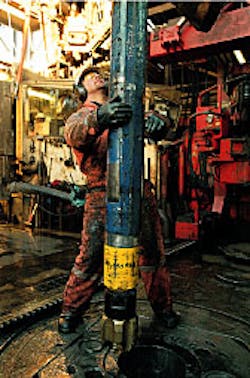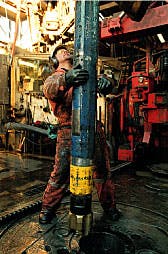Rotary-steerable system drills 300,000 ft of hole
Dean E. Gaddy
Drilling Editor
A Norwegian driller lowers the rotary-steerable, closed-loop drilling assembly into a well in Norsk Hydro's Troll field (Fig. 1).A rotary-steerable, closed-loop drilling system accumulated 300,000 ft of hole last February, achieving a significant milestone for directional drilling technologies. With more than 10,000 hr of operation in the field, the Baker Hughes Inteq/Agip SpA Autotrack system reached this mark on the extended-reach well 31/5 J-11AH in Norsk Hydro's Troll field offshore Norway (Figs. 1 and 2).
On the Troll well, the assembly geosteered through 8,586 ft of horizontal reservoir section in 8.9 days, compared to 14.3 days for offset wells drilled with conventional systems. This saved the operator $1 million in rig time.
Guidance system
Rotary-steerable systems allow the well trajectory to be actively guided while rotating the drillstring (OGJ, Dec. 21, 1998, p. 101). A downhole computer automatically steers the assembly along a planned well path while two-way communications between the surface and downhole assembly permit adjustments to the well path without interrupting the drilling process (OGJ, Mar. 2, 1998, p. 65). The technology also incorporates logging-while-drilling data within the information loop (double closed loop), providing enhanced geosteering capabilities.For steering purposes, hydraulically extendible stabilizer pads, embedded within a nonrotating sleeve, independently press against the well bore. Thus, steering occurs by applying a different hydraulic force to each pad, with the resulting force vector directing the tool along the desired trajectory.
Housed in the nonrotating sleeve are the bit inclinometer, steering-control electronics, and control valves. The drive shaft, which rotates inside the sleeve, turns the bit.
Evolution
This technology evolved from the German Continental Deep Drilling Program (Kontinentales Tiefbohrprogramm der Bundesrepublik Deutschland), involving Baker Hughes (formerly Eastman Christensen) and Ultratief Bohrgesellschaft mbh (OGJ, Nov. 11, 1991, p. 49).In this program, however, the technology was developed to maintain a near-perfect vertical well profile instead of drilling in a controlled deviated manner.
Recognizing that such a technology held great promise in directional work, Agip and Baker Hughes modified the technology for deviated and extended-reach drilling applications. Baker Hughes introduced the closed-loop system in February 1997. Since then, it has drilled more than 100 wells in the North Sea, Asia Pacific, and the U.S.
Copyright 1999 Oil & Gas Journal. All Rights Reserved.

